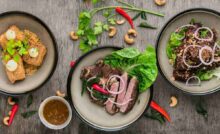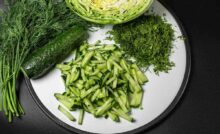Complete This Statement Food Service Gloves


Complete this statement: Food service gloves are intended to prevent pathogens from invading prepared foods, yet they can still become contaminated and require changing on an ongoing basis.
When selecting disposable gloves for food handling, choose a company with stringent standards and guidelines. Eagle Protect’s gloves are single-sourced, Delta Zero tested, and lot-certified safe to ensure manufacturing and product consistency.
Plastic
Gloves are an essential sanitary precaution in commercial food service, protecting customers and employees from germs while preventing cross-contamination. Which gloves you select depends upon your kitchen task needs and those of your staff members.
Plastic food service gloves are typically composed of light transparent polyethylene plastic called PE. While they’re economical and designed for more delicate tasks such as prepping salads or sandwiches in buffets or drive-thrus, their frequent usage contributes to global plastic waste issues and cannot be composted.
PVC gloves require plasticizer chemicals to remain flexible, including ortho-phthalates such as DINP and DIDP, which require warning labels under California’s Prop 65 law, and DPHP, which has been linked with disrupted hormones. Health advocates contacted Wendy’s, McDonald’s, and Panera Bread and requested they commit to using safer alternatives.
Nitrile food service gloves are more durable and resistant to chemicals, temperature fluctuations, oils, and allergens than their rubber latex or powder counterparts, making them an excellent choice for all forms of food handling. Furthermore, they’re latex- and powder-free – which makes them suitable for employees sensitive to rubber latex, donning powders, or common allergens; plus, they have FDA approval as food contact gloves available in standard and powder-free varieties.
Vinyl
PVC (polyvinyl chloride) is one of disposable gloves’ most frequently used materials. Its affordability, versatility, and protection against biological and chemical contaminants makes it popular, yet PVC has also become one of the world’s most significant sources of carcinogens and toxic phthalate exposure – both known to have detrimental health impacts – in addition to potentially releasing dioxins when broken down in the environment. As a result, many global healthcare institutions have reduced or banned PVC- and phthalate-containing products from their facilities, leading them to limit or even eliminate their use altogether.
Vinyl gloves are often chosen for food handling and janitorial tasks because of their sensitivity and skill when used with dry hands. Available in various colors to help color-code jobs and prevent cross-contamination, they’re also effective at protecting against oily substances, acids, emulsions, and paints.
Additionally, latex allergy sufferers will find latex-free food service gloves ideal for their dining and catering experience, as they won’t transfer latex proteins into foods that they handle. Nitrile gloves are considered the gold standard of allergy-free food service gloves because of their superior resistance to chemicals and oils than vinyl materials; additionally, they withstand higher temperatures better than latex or vinyl varieties, making nitrile an excellent choice for restaurant workers and catering company staffers.
Nitrile
Nitrile glove materials have become an increasingly popular choice due to their high durability, chemical resistance, and low risk of latex allergies. Nitrile also boasts good tactile sensitivity that makes handling tools and materials simpler for workers, while its resistance to extreme temperatures makes it suitable for food service environments where employees may face temperature-related hazards.
Nitrile or acrylonitrile butadiene rubber (NBR) gloves are the toughest disposable gloves. They often provide a skin-like fit with a firm hold that makes wearing them for extended periods comfortable and secure. Furthermore, different thicknesses are available depending on your task needs.
Nitrile gloves provide a tight, snug fit that prevents germs from entering workers’ hands and food handling, thus helping prevent cross-contamination. Soiled gloves that remain on workers could expose them to harmful contaminants that pose potential threats.
Nitrile gloves offer superior puncture resistance over latex gloves, making them an excellent choice for heavy-duty tasks like handling raw meat, fatty foods, and potentially hazardous chemicals in the kitchen. Their strength and protection make nitrile gloves a perfect addition to kitchen work!
Many states mandate that restaurants use gloves designed to be safe for people with latex allergies, and nitrile is often an ideal alternative. Unfortunately, however, some workers may still experience allergic reactions to it; in these instances, vinyl/nitrile hybrid gloves offer durability with latex allergy protection provided by vinyl.
Other Materials
Food service gloves have proven their value by significantly decreasing the risk of disease transmission during food handling. Many states mandate them as part of any comprehensive food safety protocol, yet improper usage could prove hazardous to health.
Gloves should only be worn after washing hands thoroughly with soap and water, not as a replacement for handwashing, nor should they remain worn for more than four hours to prevent bacteria from multiplying quickly and growing into harmful pathogens that contaminate the food being handled. Failure to change gloves between tasks allows microbial pathogens present on gloves to contaminate hands before being transferred onto food being held; prolonged wearing increases the chances of contamination occurring, as pathogens multiply quickly in these conditions.
The FDA requires food contact gloves made of materials recognized as generally recognized as safe (GRAS). They should not contain substances that migrate into food, endanger human health, or alter its composition or organoleptic properties. This regulation covers all disposable gloves used in food service environments. A recent report discovered vinyl food service gloves contained chemicals including DINP and DIDP (which require warning labels under California’s Prop 65), unregulated DPHP, and DEHT, which has hormone-disrupting properties; such plasticizers must be replaced by safer alternatives such as phthalates which do not have these harmful effects.
Recent Posts
How to Choose the Right IPTV Service
In this article, we will guide you through the critical factors to consider when selecting…
Maximize Your WoW Retail Leveling Boost
Before diving into optimization strategies, it's essential to understand what a WoW Retail Leveling Boost…
How to Compare Moving Company Quotes
Before diving into the comparison, it's essential to understand what a moving quote is. Essentially,…
How Spicy AI Chats Enhance Conversations
Spicy AI chats refer to engaging, dynamic, and often playful interactions powered by artificial intelligence.…
How HR Software Streamlines Small Business Operations
In today's fast-paced business world, small businesses are constantly looking for ways to streamline their…
How Physiotherapy Improves Mobility and Strength
In today's fast-paced world, maintaining mobility and strength is essential for a healthy lifestyle. These…


